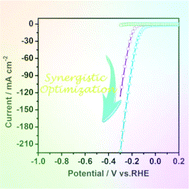Vertically aligned oxygen-doped molybdenum disulfide nanosheets grown on carbon cloth realizing robust hydrogen evolution reaction
Abstract
The catalytic activity of an electrocatalyst is determined by the density of active sites and the electric conductivity, namely, the density of electrically connected active sites. In this work, elemental incorporation, disorder engineering and material hybridization were applied to molybdenum disulfide (MoS2) simultaneously to realize a high-level synergistic optimization for both active sites and electric conductivity, achieving highly efficient hydrogen-evolving performance finally. Benefitting from the synergistic optimization, the vertically aligned oxygen-doped MoS2/carbon cloth catalyst shows an ultralow onset overpotential of 90 mV to initiate the HER process, and an extremely high catalytic current of 225 mA cm−2 was measured at an overpotential of 300 mV. Not only that, superior stability was also achieved, making this novel catalyst promising for practical applications such as electrolytic water splitting and a co-catalyst for photocatalytic/photoelectrochemical hydrogen production. The synergistic optimization strategy reported in this work would shed light on the systematic design of highly efficient electrocatalysts in the future.


 Please wait while we load your content...
Please wait while we load your content...